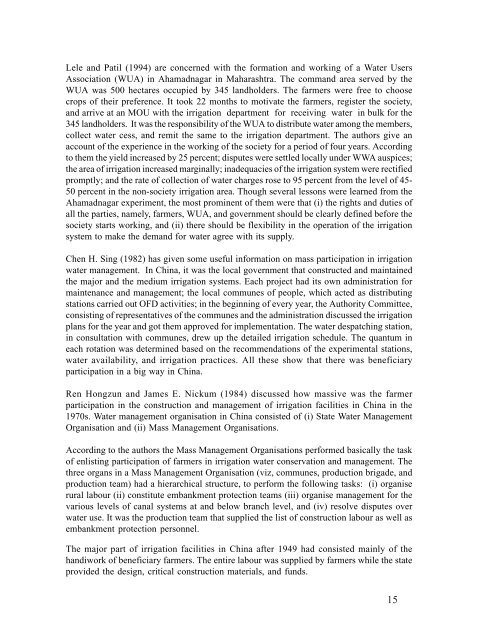Beneficiary Participation in Irrigation Water Management: The Kerala
Beneficiary Participation in Irrigation Water Management: The Kerala
Beneficiary Participation in Irrigation Water Management: The Kerala
Create successful ePaper yourself
Turn your PDF publications into a flip-book with our unique Google optimized e-Paper software.
Lele and Patil (1994) are concerned with the formation and work<strong>in</strong>g of a <strong>Water</strong> Users<br />
Association (WUA) <strong>in</strong> Ahamadnagar <strong>in</strong> Maharashtra. <strong>The</strong> command area served by the<br />
WUA was 500 hectares occupied by 345 landholders. <strong>The</strong> farmers were free to choose<br />
crops of their preference. It took 22 months to motivate the farmers, register the society,<br />
and arrive at an MOU with the irrigation department for receiv<strong>in</strong>g water <strong>in</strong> bulk for the<br />
345 landholders. It was the responsibility of the WUA to distribute water among the members,<br />
collect water cess, and remit the same to the irrigation department. <strong>The</strong> authors give an<br />
account of the experience <strong>in</strong> the work<strong>in</strong>g of the society for a period of four years. Accord<strong>in</strong>g<br />
to them the yield <strong>in</strong>creased by 25 percent; disputes were settled locally under WWA auspices;<br />
the area of irrigation <strong>in</strong>creased marg<strong>in</strong>ally; <strong>in</strong>adequacies of the irrigation system were rectified<br />
promptly; and the rate of collection of water charges rose to 95 percent from the level of 45-<br />
50 percent <strong>in</strong> the non-society irrigation area. Though several lessons were learned from the<br />
Ahamadnagar experiment, the most prom<strong>in</strong>ent of them were that (i) the rights and duties of<br />
all the parties, namely, farmers, WUA, and government should be clearly def<strong>in</strong>ed before the<br />
society starts work<strong>in</strong>g, and (ii) there should be flexibility <strong>in</strong> the operation of the irrigation<br />
system to make the demand for water agree with its supply.<br />
Chen H. S<strong>in</strong>g (1982) has given some useful <strong>in</strong>formation on mass participation <strong>in</strong> irrigation<br />
water management. In Ch<strong>in</strong>a, it was the local government that constructed and ma<strong>in</strong>ta<strong>in</strong>ed<br />
the major and the medium irrigation systems. Each project had its own adm<strong>in</strong>istration for<br />
ma<strong>in</strong>tenance and management; the local communes of people, which acted as distribut<strong>in</strong>g<br />
stations carried out OFD activities; <strong>in</strong> the beg<strong>in</strong>n<strong>in</strong>g of every year, the Authority Committee,<br />
consist<strong>in</strong>g of representatives of the communes and the adm<strong>in</strong>istration discussed the irrigation<br />
plans for the year and got them approved for implementation. <strong>The</strong> water despatch<strong>in</strong>g station,<br />
<strong>in</strong> consultation with communes, drew up the detailed irrigation schedule. <strong>The</strong> quantum <strong>in</strong><br />
each rotation was determ<strong>in</strong>ed based on the recommendations of the experimental stations,<br />
water availability, and irrigation practices. All these show that there was beneficiary<br />
participation <strong>in</strong> a big way <strong>in</strong> Ch<strong>in</strong>a.<br />
Ren Hongzun and James E. Nickum (1984) discussed how massive was the farmer<br />
participation <strong>in</strong> the construction and management of irrigation facilities <strong>in</strong> Ch<strong>in</strong>a <strong>in</strong> the<br />
1970s. <strong>Water</strong> management organisation <strong>in</strong> Ch<strong>in</strong>a consisted of (i) State <strong>Water</strong> <strong>Management</strong><br />
Organisation and (ii) Mass <strong>Management</strong> Organisations.<br />
Accord<strong>in</strong>g to the authors the Mass <strong>Management</strong> Organisations performed basically the task<br />
of enlist<strong>in</strong>g participation of farmers <strong>in</strong> irrigation water conservation and management. <strong>The</strong><br />
three organs <strong>in</strong> a Mass <strong>Management</strong> Organisation (viz, communes, production brigade, and<br />
production team) had a hierarchical structure, to perform the follow<strong>in</strong>g tasks: (i) organise<br />
rural labour (ii) constitute embankment protection teams (iii) organise management for the<br />
various levels of canal systems at and below branch level, and (iv) resolve disputes over<br />
water use. It was the production team that supplied the list of construction labour as well as<br />
embankment protection personnel.<br />
<strong>The</strong> major part of irrigation facilities <strong>in</strong> Ch<strong>in</strong>a after 1949 had consisted ma<strong>in</strong>ly of the<br />
handiwork of beneficiary farmers. <strong>The</strong> entire labour was supplied by farmers while the state<br />
provided the design, critical construction materials, and funds.<br />
15










